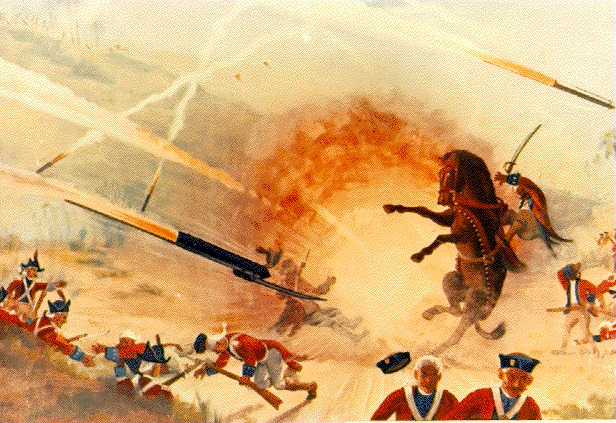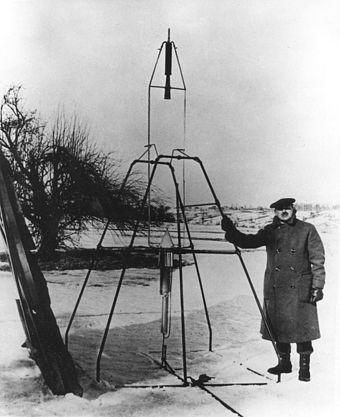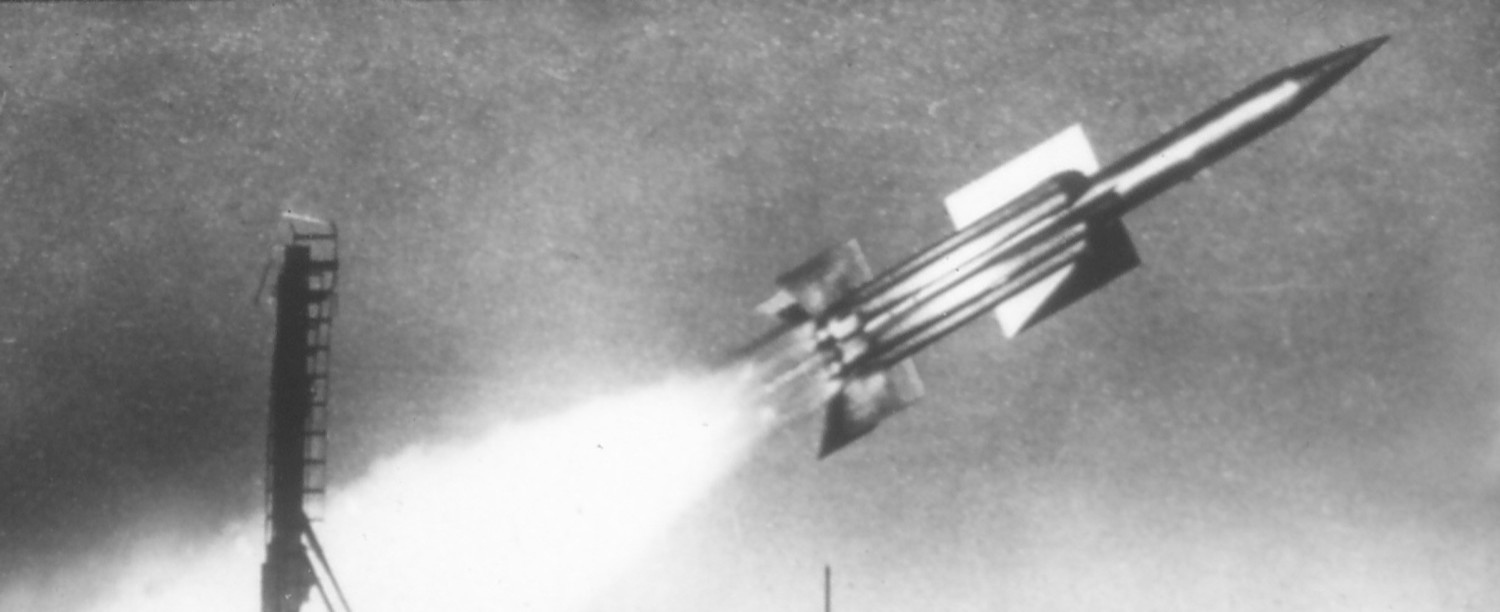First Rockets
The first gunpowder-powered rockets evolved in medieval China under the Song dynasty by the 13th century. The Mongols adopted Chinese rocket technology and the invention spread via the Mongol invasions to the Middle East and to Europe in the mid-13th century.[4] Rockets are recorded[by whom?] in use by the Song navy in a military exercise dated to 1245. Internal-combustion rocket propulsion is mentioned in a reference to 1264, recording that the "ground-rat", a type of firework, had frightened the Empress-Mother Gongsheng at a feast held in her honor by her son the Emperor Lizong.[5] Subsequently, rockets are included in the military treatise Huolongjing, also known as the Fire Drake Manual, written by the Chinese artillery officer Jiao Yu in the mid-14th century. This text mentions the first known multistage rocket, the 'fire-dragon issuing from the water' (Huo long chu shui), thought to have been used by the Chinese navy.[6]
Medieval and early modern rockets were used militarily as incendiary weapons in sieges. Between 1270 and 1280, Hasan al-Rammah wrote al-furusiyyah wa al-manasib al-harbiyya (The Book of Military Horsemanship and Ingenious War Devices), which included 107 gunpowder recipes, 22 of them for rockets.[7][8] In Europe, Konrad Kyeser described rockets in his military treatise Bellifortis around 1405.[9]
What's in a name?
The name "rocket" comes from the Italian rocchetta, meaning "bobbin" or "little spindle", given due to the similarity in shape to the bobbin or spool used to hold the thread to be fed to a spinning wheel. Leonhard Fronsperger and Conrad Haas adopted the Italian term into German in the mid-16th century; "rocket" appears in English by the early 17th century.[1] Artis Magnae Artilleriae pars prima, an important early modern work on rocket artillery, by Kazimierz Siemienowicz, was first printed in Amsterdam in 1650.

The Mysorean rockets were the first successful iron-cased rockets, developed in the late 18th century in the Kingdom of Mysore (part of present-day India) under the rule of Hyder Ali.[10] The Congreve rocket was a British weapon designed and developed by Sir William Congreve in 1804. This rocket was based directly on the Mysorean rockets, used compressed powder and was fielded in the Napoleonic Wars. It was Congreve rockets that Francis Scott Key was referring to when he wrote of the "rockets' red glare" while held captive on a British ship that was laying siege to Fort McHenry in 1814.[11] Together, the Mysorean and British innovations increased the effective range of military rockets from 100 to 2,000 yards.
The first mathematical treatment of the dynamics of rocket propulsion is due to William Moore (1813). In 1815 Alexander Dmitrievich Zasyadko constructed rocket-launching platforms, which allowed rockets to be fired in salvos (6 rockets at a time), and gun-laying devices. William Hale in 1844 greatly increased the accuracy of rocket artillery. Edward Mounier Boxer further improved the Congreve rocket in 1865.

William Leitch first proposed the concept of using rockets to enable human spaceflight in 1861.[12] Konstantin Tsiolkovsky later (in 1903) also conceived this idea, and extensively developed a body of theory that has provided the foundation for subsequent spaceflight development. In 1920, Professor Robert Goddard of Clark University published proposed improvements to rocket technology in A Method of Reaching Extreme Altitudes.[13] In 1923, Hermann Oberth (1894–1989) published Die Rakete zu den Planetenräumen ("The Rocket into Planetary Space")
Modern Rockets
Modern rockets originated in 1926 when Goddard attached a supersonic (de Laval) nozzle to a high pressure combustion chamber. These nozzles turn the hot gas from the combustion chamber into a cooler, hypersonic, highly directed jet of gas, more than doubling the thrust and raising the engine efficiency from 2% to 64%.[13] His use of liquid propellants instead of gunpowder greatly lowered the weight and increased the effectiveness of rockets. Their use in World War II artillery developed the technology further and opened up the possibility of human spaceflight after 1945.
In 1943 production of the V-2 rocket began in Germany. In parallel with the German guided-missile programme, rockets were also used on aircraft, either for assisting horizontal take-off (RATO), vertical take-off (Bachem Ba 349 "Natter") or for powering them (Me 163, see list of World War II guided missiles of Germany). The Allies' rocket programs were less technological, relying mostly on unguided missiles like the Soviet Katyusha rocket in the artillery role, and the American anti tank bazooka projectile. These used solid chemical propellants.
The Americans captured a large number of German rocket scientists, including Wernher von Braun, in 1945, and brought them to the United States as part of Operation Paperclip. After World War II scientists used rockets to study high-altitude conditions, by radio telemetry of temperature and pressure of the atmosphere, detection of cosmic rays, and further techniques; note too the Bell X-1, the first crewed vehicle to break the sound barrier (1947). Independently, in the Soviet Union's space program research continued under the leadership of the chief designer Sergei Korolev (1907–1966).
During the Cold War rockets became extremely important militarily with the development of modern intercontinental ballistic missiles (ICBMs). The 1960s saw rapid development of rocket technology, particularly in the Soviet Union (Vostok, Soyuz, Proton) and in the United States (e.g. the X-15). Rockets came into use for space exploration. American crewed programs (Project Mercury, Project Gemini and later the Apollo programme) culminated in 1969 with the first crewed landing on the Moon – using equipment launched by the Saturn V rocket.
